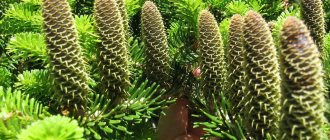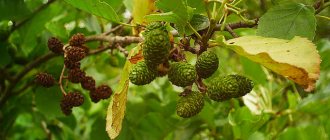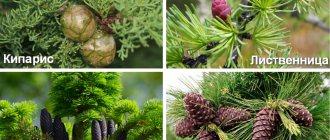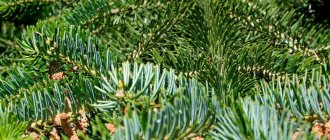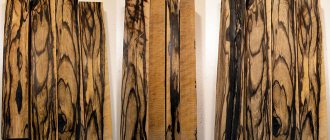Oak is a symbol of power and greatness. Its average lifespan is 100–200 years. This means that if you decorate your garden with such a tree, it will grow and delight several generations of your relatives with its beauty.
For normal growth and development, oak requires a large area. This tree is decorated with a spreading, dense, tent-shaped crown, which will give you great shade. This plant is also attractive because it requires little care.
To grow a mighty oak, it is enough to plant a ready-made seedling on your plot. If desired, a tree can be grown from an acorn.
Features of oak
The widely known deciduous oak tree is a perennial and belongs to the Beech family. The natural distribution area of such a plant is the northern hemisphere, or more precisely, regions with a prevailing temperate climate.
The foliage of such a tree has an unusual lobed shape, characteristic of oak. There are varieties whose leaves are whole. The nut-like fruits that form on the branches are called acorns. This genus is represented not only by trees, but also by shrubs, the maximum height of which is 200–300 centimeters.
Some varieties are evergreens. Their spectacular leathery leaf plates do not fly off the branches for several years.
Due to the fact that the powerful branches of such a tree bend, they form a voluminous “tent” that saves you from the heat on a hot summer day.
As a rule, a tree produces its first fruits only after it turns 15 years old. But in some cases, the first fruiting is observed even after sixty years. The time of the first fruiting is influenced by the area where the oak grows. In an open and sunny area, the fruits appear earlier.
Different types of oak differ from each other in color, size and shape of acorns. They are large and small, flattened or elongated, dark brown (cinnamon color) or pale brown. Oak fruits ripen in autumn, more precisely in September and October.
Most species of this plant are characterized by slow growth, while they are long-lived. Their crown grows large, wide and dense. On average, such trees live from 200 to 300 years. However, there are also long-lived oaks, whose age exceeds 2 thousand years.
Such a powerful plant can reach a height of 50 m, and its trunk in girth is from 6 to 7 m. Moreover, there is information that until the oak tree turns 80 years old, it actively increases in height. And after eighty years it begins to rapidly grow in width.
The young tree is covered with smooth bark, the surface of which is slightly shiny. Over the years, it becomes rougher and cracking is observed.
The time when oak begins to bloom directly depends on the region; approximately, it falls in April or May. Unisexual small flowers have the appearance of so-called “catkins”. Powerful roots go deep into the ground, while branching greatly.
This tree is distinguished by its light-loving nature, and it is also demanding on the composition of the soil. Adult specimens are highly drought and frost resistant. At this age they require almost no care.
Life cycle of oak
Aging in oak barrels - what is it for?
Not all alcoholic drinks are aged in barrels. Many light red and white wines, fruit distillates from plums, cherries or strawberries are consumed fresh.
But for most full-bodied and fortified red wines, as well as ports, this is a mandatory procedure. And strong drinks such as whiskey, rum or cognac will remain a clear distillate without aging. More than 500 chemical reactions take place in barrels, as a result of which drinks receive their unique organoleptic properties.
Distillers have such a concept as the “barrel triangle.” One side of it is the nature of the raw materials, preserved in the distillate. The second is the properties of the barrel, which depend on the tree, the place where it grew, and the skill of the cooper. All this gives birth to a third side - the final product, which acquires new noble features.
From this wisdom of distillers we come to the conclusion: if the first two sides of the triangle suffer, then we will not get high-quality alcohol. You should not put bad distillate or store-bought vodka into a good barrel. And vice versa - an unscrupulously made keg will easily ruin your drink.
Interesting facts about oak
Oak is one of the most powerful and majestic long-lived plants. In ancient Rome, centuries-old oak trees were considered a wonder of the world. At the same time, their age was compared with the age of the Universe itself.
Among the Slavs, oak was a symbol of one of the main trees of the universe, the so-called “World Tree”. This was a model of the special relationship between the Universe and people. In Ancient Greece, oak symbolized longevity.
This majestic plant is praised in the works of many folklorists, poets and composers. In France you can find a very interesting oak tree, which is more than 200 years old. A room was made in his hollow that anyone can visit.
Virginia oak wood is highly durable. Moreover, it does not lose this property even when in water. A ship made from such wood could reflect cannon balls from its own side.
Today, a large number of oak varieties are used for landscaping public gardens, parks and local areas.
Pictures of leaves
When many people mention an autumn park, a picture from a botany textbook with an image of an oak leaf appears before their eyes. There are also those who collect herbariums and even keep special albums. But you can also sketch it in your sketchbook.
If desired, in the fall everyone will be able to try themselves as an artist. You need to go to the park, collect oak leaves there and create a whole collage.
To make it easier to draw a leaf, you can simply trace it on paper with a pencil, like a template. And then everything depends solely on imagination and artistic skills.
For example, you can color the drawing with watercolors, pencils or felt-tip pens. And you can take any shades - you can find many photos and drawings that will suggest the palette option.
We recommend that you read The Smell of Pine
If the color of summer leaves varies from light to dark green, then in autumn brown, brownish, yellow, and bright red shades are possible. At the same time, the veins always seem darker, and sometimes they are contrasting. A little patience and the picture will be ready.
Types of oaks with photos and names
In total there are more than 600 species of oak. Those types that are most popular will be discussed below.
White oak (Quercus alba)
This plant is native to North America. This spreading, tall plant has a wide, tent-shaped crown with a flat top. The average height of such a tree is approximately 30 m. The whitish (grayish) bark cracks slightly over time.
The oval lobed leaf blades are quite large. A characteristic feature of this species is that during the opening period its leaf blades have a rich red color. However, during the summer their unusual color changes to green. Often the front surface of the foliage has a bluish tint. This tree is highly decorative and resistant to frost. It is suitable for growing in urban environments.
Red oak (Quercus rubra)
This highly decorative species grows well in moist soil, so most often it can be found on the banks of various reservoirs, including rivers. However, this tree reacts negatively to stagnant water. Its average height is about 25 m. The oak tree is decorated with a leafy and lush crown, while its trunk and branches are covered with smooth gray bark. Over the years, cracking of the bark has been observed.
The opening foliage is red in color, as are the young shoots. By the beginning of summer, the leaves turn green, and in the fall they turn brown-red. The fruits are brownish-red. The plant is distinguished by its light-loving nature, resistance to frost and a number of diseases. It is not harmed by side shading.
English or common oak (Quercus robur)
This powerful, vigorous plant has an average height of about 50 m. Its main decoration is a spreading crown and an even trunk. This species is a long-livers; when optimal conditions are created, it is able to grow in the same place for approximately 1–1.5 thousand years.
Before the plant is 40 years old, its bark is brownish-green in color. Over the years, the color becomes darker, almost black. This tree grows well in nutritious soil and is resistant to drought. This species is widespread throughout the Russian Federation.
In culture, the most popular varieties of this species are: weeping oak, columnar oak and comb-dissected oak.
Swamp oak (Quercus palustris)
The species was named so due to the area in which it prefers to grow in natural conditions. And it grows on the banks of swampy areas, and also next to lakes and rivers. The plant has a slender trunk, the height of which does not exceed 25–30 m.
The lush spreading crown has a slightly rounded shape. The stems are colored brown. The trunk is covered with smooth olive-colored bark. The foliage of the species is green, and in autumn it turns a spectacular purple color. The species is characterized by average resistance to frost, and it is also demanding on the quality and moisture of the soil.
Holm oak (Quercus ilex)
The height of this spectacular evergreen species is about 25 m. The trunk is covered with smooth gray bark. The tree is decorated with a lush crown. There is pubescence on the underside of the small bright green leaf blades. This fast-growing plant has high drought and frost resistance, as well as shade tolerance. Grows well on rocky soil.
Large-fruited oak (Quercus macrocarpa)
The average height of an adult plant is about 30 m. The shape of the crown has the shape of a tent. The pale brown bark on the trunk cracks over time. The oval fruits are relatively large, which influenced the choice of the name of the species. The plant is moisture-loving and frost-resistant.
Chestnut oak (Quercus castaneifolia)
The plant was listed in the Red Book. Its height can reach up to 30 m. Large leaf blades have a shape similar to the seed chestnut. The front surface is smooth, dark green, and the back is gray and has slight pubescence. The tree is moisture-loving and frost-resistant.
Mongolian oak (Quercus mongolica)
The first description of this plant was made in Mongolia, which influenced the choice of the name of the species. Today, this variety is widespread in Korea, Japan and Russia (especially in the Far East). On average, such an oak lives from 300 to 400 years.
The height of this plant varies from 20 to 30 m. However, in mountainous areas on rocky soil, this oak is found in the form of a shrub, the height of which does not exceed 10 m. These features of the plant made it possible to use it to strengthen plantings and slopes in mountainous areas. The small fruits are round in shape.
Sessile oak (Quercus petraea)
This plant is very similar to pedunculate oak in its morphological features. However, this species grows well on rocky soil in mountainous areas due to its branched and powerful root system. The maximum height of the tree is about 30 m. In Russia, such a tree is most widespread in the Caucasus.
Today there are many varieties and forms that are used to design various landscapes. In culture, decorative forms of oak are the most popular for decorating parks and gardens, namely: columnar, weeping, and also with spectacular unusual foliage colors. Most varieties obtained through selection differ from natural species in that they are smaller in size.
Beneficial features
Not only oak bark has beneficial properties. For example, acorns are used to treat intestinal disorders, hernias and skin diseases.
Oak foliage smells pleasant and is an obstacle to the development of rot. Fragrant bath brooms are made from tree branches. The leaves are used to line tubs intended for pickles. The preparations do not sour and become especially tasty.
You can also make children's crafts from acorns. Acorns look very beautiful: they have a round shape and a pleasant glossy shine.
Autumn oak is an amazing sight. A mighty crown of yellow foliage pleases the human eye. When the leaves of the buzzards dry out, they remain on the branches, attracting attention with a quiet and mysterious winter rustle.
According to various sources, the oak family reaches 450...600 species. Representatives grow in different parts of the planet in temperate latitudes, where the climate suits the needs of the tree.
Growing oak from an acorn, planting a seedling
Many gardeners use three methods to propagate oak trees on their property: green cuttings, acorns, and ready-made purchased seedlings. In this case, seedlings can be bought at a specialized nursery or garden store.
Oak can be propagated by cuttings. It should be taken into account that out of 10 one-year-old shoots, approximately 8 will take root, and from the same number of two-year-old shoots - from 4 to 6 pieces.
Where to get acorns
If possible, you can collect acorns with your own hands in the autumn under a mature oak tree. After the acorns are fully ripe, they fall to the soil surface on their own. Such acorns can be planted in open ground in the autumn. You can also save them until spring and start planting when the weather warms up.
You can search for acorns in the spring, when the snow cover melts. At this time they will already have sprouted or sprouted. It is recommended to immediately plant such fruits in the soil. If necessary, they can be stored for a short time in damp sand.
Preparing for sowing
In order for acorns to germinate, they need to be of high quality. Acorns are collected in autumn only after they have matured well, and the weather must be dry. The acorn's cap protects it from injury. In a well-ripened fruit, it peels off easily.
It is recommended to choose large, whole fruits that are not rotten and do not have gnaws or cracks. Healthy, strong fruits can be planted in the soil in the garden without prior preparation. You can also plant acorns in a container. After the seedlings have grown and become stronger, they are planted in a permanent place in the garden.
To understand whether the fruit in front of you is viable or not, you need to examine its inside. If the acorn is alive and suitable for planting, it will be yellow inside and the embryo will be clearly visible. In dead fruits, the core has a dark color.
Rules for storing acorns
After preliminary preparation, oak fruits can be sent for storage. The collected acorns are laid out in a dry place and kept for 7–15 days at room temperature. During this time they should dry out. Next, they are stored in a cold (0 to 2 degrees) place, and the air humidity should be high. For example, they can be lowered into the cellar or placed on the refrigerator shelf, after placing them in a container filled with sand. The fruits remain viable for 12 months, so there is no point in storing them longer.
Experts do not advise storing oak fruits in a tightly closed container or bag, as they may die. During storage, it is recommended to regularly inspect acorns for mold. When it appears, the fruits are thoroughly washed and dried. Then they are put away again for storage.
If the fruits in storage look dry and too dark in appearance, then they most likely will not sprout. Before planting, acorns can be checked for germination: they are placed in a container filled with water. Those fruits that have sunk to the bottom are viable. And those acorns that remain on the surface of the water can be thrown away.
You can also save fruits collected in the fall in the open ground. To do this, they are buried in the ground in the garden to a depth of 20 to 25 centimeters. They are covered on top with material that does not allow water to pass through. Mark the storage location so it can be easily found in the spring.
How to grow an Oak tree from an acorn. From an acorn to a 25cm seedling.
What time to plant acorns
The harvested fruits can be planted directly into the soil in the garden. Also, if desired, you can grow seedlings at home, after which they are planted in open ground. In this case, the first planting method is the simplest and most common.
Acorns are planted in autumn or fall. If planting is carried out in the autumn months, then during the winter the fruits will be able to undergo natural stratification. And with the onset of spring, powerful, hardened seedlings will appear from them. In autumn, planting is carried out approximately 4 weeks before the first frost.
If planting is planned in the spring, then in this case you need to wait until the soil warms up well.
Rules for planting acorns
In order to prevent drying out or the appearance of rot during thaws in winter, during planting in autumn, acorns should be buried 70–100 mm into the ground. If planting is done in the spring, then it will be enough to bury the fruits into the soil by 40–50 mm.
To prevent the appearance of mold on acorns due to heavy rainfall, as well as to protect them from animals, plantings carried out in the fall are covered with any material that does not allow water to pass through. You can more reliably protect acorns from rodents and animals whose diet includes nut-like fruits by immersing them in kerosene for a while shortly before planting.
If you are planting several fruits on a tree, then first make grooves and moisten them. A distance of 10 to 30 centimeters is maintained between acorns, and the distance is influenced by both the size of the fruit itself and the type of oak. When planting is complete, level the soil surface.
When planting hatched fruits, it is necessary to act extremely carefully, because young roots are characterized by increased fragility, that is, they break easily. Planting such fruits can also be done directly into the soil in the garden or into a container for germination, most often using a plastic cup. First, fill the container with a substrate to which you add a little moss. Plant the fruit in it, deepening it 30–40 mm, with the root pointing down. Remember that there must be holes for drainage at the bottom of the container. Do not forget to systematically water the plantings and provide them with good lighting. After the seedlings have formed 2 or 3 true leaf blades, they should be picked into larger containers or planted in open ground.
Remember that germination of oak fruits occurs extremely slowly. First, the development and growth of the root is observed, and only then a shoot appears. The first seedlings can be seen only 4–6 weeks after planting the fruits.
Planting oak from acorn and stratification
Selection of seedlings
It is much easier to plant in your garden already purchased seedlings that are 1 or 2 years old. If the seedling has an open root system, then during transportation it should be wrapped in cloth, which must be moistened. Before planting the seedling, cut off all damaged roots. If the root system looks weak, then when planting, all stems should be shortened by 1/3.
If the seedling has a closed root system, then the chances that it will successfully take root in a new location increase to almost 100 percent. They are planted immediately in a permanent place, while trying not to destroy the earthen lump.
Choosing a landing site
It is recommended to plant oak seedlings in well-lit open areas, but it should be taken into account that an adult plant requires a lot of space. The minimum distance from a seedling to a building is 3-4 m, and to a neighboring large plant - 3-6 m. It is highly not recommended to break this rule, because the strong and strong roots of an adult tree can destroy both the blind area located next to the building and foundation.
Nutritious, neutral or slightly acidic soil is best suited for growing oak. An earth mixture is also suitable, which contains 2 parts each of turf soil and sand, and another 1 part peat. To increase the fertility of the composition, it is recommended to add humus to it.
Growing seedlings in school
Most often, seedlings that are 1 year old need to be planted in a permanent place in open ground. Transplantation helps stimulate the growth and branching of the seedling's root system. It is recommended to plant such a seedling in the spring. Thanks to this, even if the root system is injured, it will be able to recover even before the buds open.
The seedlings are planted in moist soil saturated with nutrients. At first, the planted seedling will be “sick,” and it will also adapt to new conditions. When the tree has fully recovered, it will begin to grow and its development will begin.
When planting several seedlings, furrows are prepared. Do not forget to maintain a distance of 15–20 centimeters between plants. In the autumn, the grown seedlings from the school can be moved to a permanent place. The weakest seedlings can be left in school until next autumn.
Rules for planting seedlings
Preparing the pit should be done 15–20 days before planting. Its depth should be about half a meter and its width about 1 meter. When digging a hole, the nutritious top layer of soil must be carefully removed and stored separately. Fill the bottom of the hole with a layer of drainage 10 to 20 centimeters thick. Then the top layer of soil is poured into it, which must first be mixed with fertilizers. Recommended fertilizers: 1 kg of wood ash, 5 to 6 kg of rotted manure, 1.5 to 2 kg of double superphosphate, 5 kg of compost and 60–70 grams of potassium sulfate and potassium chloride.
When planting a seedling, pay attention to the fact that its root collar should rise several centimeters above the soil level. Do not forget to compact the surface of the soil around the planted plant well, after which it is provided with abundant watering. When the water is completely absorbed into the ground, the surface of the tree trunk circle should be covered with a layer of mulch, which can be compost, mowed weeds or humus.
Oak planting
Oak care
A mature oak tree does not need any special care. However, the seedling requires closer attention from the gardener.
Watering and loosening
Young seedlings need to be systematically watered, weeded, and also provided with regular loosening of the soil surface. Compared to coniferous seedlings, oak is more resilient and drought-resistant. Immediately after planting the seedling, during the first 4–5 days it must be systematically watered abundantly. Next, the frequency of watering is adjusted depending on natural precipitation. Remember that during a prolonged drought, young oak needs timely watering.
When there are 6 to 8 weeks left before the massive autumn leaf fall, they stop watering the oak completely. This is necessary so that the tree can properly prepare for winter. When the plant is watered, as well as in late autumn, the surface of its trunk circle should be mulched with wood shavings, peat or plucked grass. The layer thickness can vary from 70 to 100 mm.
Fertilizer
The first feeding is carried out in the second year of growth of the planted seedling. In spring, for these purposes it is recommended to use mineral fertilizers containing nitrogen, for example, ammonium nitrate. Organic matter, such as urea or cow manure, will also work.
At the beginning of the autumn period, a mineral complex, for example, nitroammophoska, can be added to the soil. When planting large seedlings, it is recommended to add a biostimulant to the soil. Thanks to it, the plant will quickly take root and adapt to new conditions.
Trimming
Every year it is necessary to carry out sanitary pruning of oak trees. To do this, cut out all injured, dried and diseased branches. You should also cut out all the shoots that grow inside the crown.
At the beginning of the spring period, formative pruning is carried out. This is done before the sap begins to flow around the tree.
In order for crown growth to become slower or stop altogether, the dominant main shoot should be pruned. This procedure should be repeated once every 2 or 3 years.
Preparing for winter
For several years after planting, seedlings must be covered for the winter. To do this, mulch the tree trunk with fallen leaves or peat, and insulate the plant itself by wrapping it with covering material (any kind will do).
Pests and diseases
Young oak trees are often affected by powdery mildew, which causes a whitish coating to appear on the surface of the foliage. An adult plant is resistant to this disease. If a young seedling is affected by powdery mildew, it is sprayed with a systemic fungicidal preparation, for example, a solution of Fundazol (0.8%), copper sulfate (1%) or a sulfur suspension. These drugs can also be used for preventive treatments.
Putrefactive fungi and tinder fungi can also settle on the tree, which can cause necrosis of the stems. Dead branches are cut off. Next, the cut areas are coated with garden varnish or treated with copper sulfate.
Various pests can cause damage to oak trees. Silkworms, moths, cutworms, moths or leaf rollers settle on the foliage. Flowers and buds are damaged by the gallworm. And acorns can be harmed by codling moths and weevils.
To get rid of insect pests, treat with an insecticide, for example: Kinmiks, Karbofos, Fitoverm, Intavir, etc. The plant is treated twice: in spring and summer.
